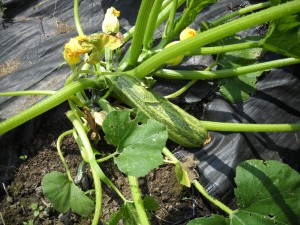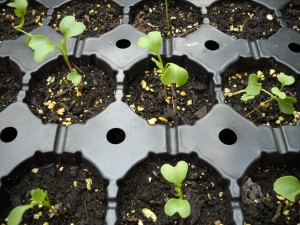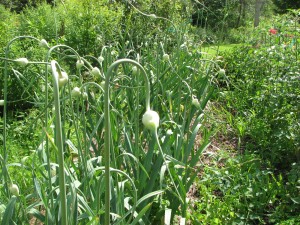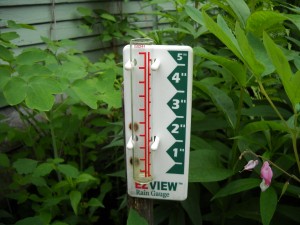Mid-Summer in the Vegetable Garden
Summer squash of all sorts are ripening up nicely, so I know it’s mid-summer in the vegetable garden. Soon gardeners will be dropping off bags of squash in unlocked cars, on porches, and, occasionally, on seats of buses and in public libraries. When you’re not distributing the booty in creative ways, here are some suggestions for tasks in your vegetable garden now.
If you see lower leaves of tomato plants browning up, snip them off with a sharp pair of scissors and dispose of them in your trash, not the compost. It’s a good year for tomatoes, so far. No late blight, not much early blight for most of us. On a recent tour of my 32 tomato plants, I only found a few that had any discolored leaves at all. This may be due to the fact that when I installed tomato cages in June, I cut off lower leaves that might touch the ground. Most leaf diseases are soil-borne and spread by splash-up. So removing lower leaves, even now, is a good practice. Mulching with leaves, straw, hay, pine needles or grass clippings helps prevent disease, too.
I’m eating edible-pod peas and freezing some for the winter. I blanch them briefly – about 60 seconds- and drop them into cold water before patting them dry on cotton towels, and then freezing them in zipper bags. Once the crop is finished I’ll have a nice 10-foot section of wide raised garden bed for planting late season veggies. Here are some possibilities of ways to use that bed:
1. Fall radishes. I buy seeds for one called ‘Red Meat’ in the Johnny’s Seeds catalog that I love. It only works if you plant it in mid-to late-summer. It is very mild, and pretty on a plate. Pink centers are surrounded with a band of white, then green – just like a watermelon. It is tasty even if grown 3 to 4 inches in diameter. I serve it with a vinaigrette sauce. At the Cornish General Store I found seeds by Agway for a fall radish called Chinese White Winter; the packet says to plant after August 15. It grows to 5 inches long or more, stores well, and is mild. I shall try it.
2. Late season broccoli. Start some by seed now in cell packs, transplant into the garden when they are 2-3 inches tall. You’ll have full sized heads in 55-65 days. Or buy seedlings now if you can find them. Broccoli produces well into the fall as it is very frost hardy.
3. Bush Beans. I have 2 plantings already, but I could do a third planting for the freezer. ‘Provider’, a reliable variety, takes just 50 days from planting to harvest, and will produce for 3 weeks or more. If you plant today, you should be able to harvest plenty before frost.
4. Lettuce. Fall lettuce is crisp and tasty. Plant directly in the soil, or if you have no space now, plant in cell-packs, and plant when you have space.
Other tasks now? Scratch in a little rock powder or wood ashes around pepper plants. Peppers produce late in the summer, and can be stimulated to be more fruitful, sooner, with a dose of rock powder now – a quarter cup per plant. For more information on rock powders, see my latest book (Organic Gardening (not just) in the Northeast: A Hands-On, Month-by-Month Guide), which should be available at your local library or bookstore. Azomite is the name of one commercially available rock powder.
Your asparagus patch should not be ignored, just because the season is over. Make sure grasses and weeds don’t take over the bed, and water weekly in dry times. I mulched mine with ground branches I got from a local arborist. The chips keep down weeds and hold in moisture.
Make pesto. Basil is more productive if you keep picking leaves or even cutting off the top third of the plant. There is only so much basil you can put in a salad or on a sandwich, so make some pesto and freeze it for the winter when we all crave green things from the garden. The basic recipe contains basil, garlic (lots), parmesan cheese, olive oil and pine nuts. In recent years, pine nut prices have peaked over $20/pound, so I have been using walnuts or hazel nuts, both of which taste just fine.
My garlic is getting mature earlier than usual this year. When the tops, called scapes, curl around in loops it is time to harvest those scapes and use in stir fries. Chop and sauté in olive oil to add to other vegetable dishes. The heads, or bulbs, will continue getting bigger for a few more weeks- but I have already nabbed a couple to use now. When you do harvest your garlic, it is best to let it cure for a couple of weeks in a shady, breezy location before you cut off the tops.
It’s easy to get lackadaisical in the heat of the summer, but weeding is still important if you want your best production. It is also important to keep weed seeds out of the soil to minimize your work next year. So keep weeding, but at the end of the day settle into an Adirondack chair near the garden and admire your handiwork as the sun goes down.
Henry Homeyer is a garden consultant, teacher, coach and the author of 4 gardening books. His web site is www.Gardening-Guy.com.
Gardening in the Rain
I’ve always preferred sunny days, both as a boy and now, as a quasi-geezer. I remember reciting this ditty as a small boy, “Rain, rain, go away, come back some other day!” And it did, eventually – but usually not as quickly as I wanted. Now as a gardener I appreciate the rain for what it does for my plants, but I still think to myself, after a few hours of rain, “Rain, rain, go away …”
If you don’t have a rain gauge, you should. It doesn’t have to be one of those fancy electronic ones that sends signals to you from outdoors. A simple $5 device that consists of a cylinder with marks on the side to show each quarter inch of rain is just fine. And, if you really want to be frugal, an empty cat food or tuna can will work. Most of our plants need an inch of rain – or water from your hose – each week.
Plants are generally the most susceptible to death by dehydration right after planting. Their roots have been disturbed and frequently delicate root tips have been broken off. A hot, dry day can wreak havoc on a newly planted seedling. If your plants are growing in potting mix, it is best to submerse the plants in a bucket of water before nestling them into their growing holes. Hold the plants under the water until they stop bubbling. It can be hard to saturate a large root ball by top watering.
Rainy days are much better than sunny days for transplanting. You can minimize shock by preparing the new hole before you dig up the plant so that it can go right to its new home. My grandfather liked to say that you should move enough soil with a transplant that “it will remember where it came from.” Modern soil scientists would probably agree, saying that the soil microbes you move with a plant are important to its future health. After moving a plant, create a ring of soil around your transplant to hold water. Then, using a watering can, gently fill the ring and let water seep in. Repeat several times.
I add two solutions to my watering can that help to minimize transplant shock. The first is called SUPERthrive. It comes in a little 4oz container but it only takes a quarter of a teaspoon of the solution for a gallon of water to treat plants against transplant shock. It contains vitamins and minerals; in my experience it reduces transplant shock and helps stressed plants (like those 6-packs of annuals I forgot to water on a hot day).
The other solution I use is a liquid fish and seaweed fertilizer. Neptune’s Harvest makes a very nice product, though there are plenty of others. The fish “juice” gives new plants nitrogen, phosphorous, potassium and trace minerals at a time when they need a quick burst of soluble fertilizer.
But back to those rainy days: if you don’t mind working a warm rain, go outside and weed. Weeds pull much more easily when the soil is wet. But avoid a lot of digging in wet soil. I like my CobraHead weeder (www.CobraHead.com), in part, because it is a low-impact tool. I can use its single tine to stir up the soil enough to plant a small lettuce plant or make a furrow for carrot seeds without making a big mess of the soil on a rainy day.
I never walk on beds when they are wet. Wet soil compacts easily, especially soils with a high clay content. Clay that is compacted and then allowed to dry out can be as hard as concrete. And don’t even think of rototilling wet soil. You can ruin the soil texture by doing so.
Most of us have plants in pots on the front stoop or on the deck. Be attentive to them when it rains. If they have drainage holes (as they should), they will collect water in their saucers below. Roots can rot if left sitting in water for days on end. So remove the plants from their saucers in a deluge, or shortly thereafter. If you notice that the runoff is brown, you are probably losing good nutrients. Pour that water in a bucket to use on a dry day to water your plants.
Want an indoor planting project on a rainy day? Get out your potting soil and a few leftover 6-packs from spring planting. Plant some lettuce seeds in those 6-packs for use in the garden once they get to be an inch or two tall. I find that starting lettuce in 6-packs and growing them on the deck is better than direct seeding in the garden – no weeds, and they are easier to monitor for water. I try to remember to plant lettuce every 2 weeks for a good supply all summer. And you can start fall broccoli by seed in mid-July- so mark your calendar today, and do so on a rainy day.
There are times in early summer when I get bone tired from doing so much gardening, day after day. I can’t seem to get it through my thick skull that I’m not a kid anymore. So a rainy day is a good thing. It usually forces me slow down a little. And my plants love them – in moderation.
Henry Homeyer is a life-long organic gardener, a UNH Extension Master Gardener, and a gardening coach. Contact him at henry.homeyer@comcast.net or P.O. Box 364, Cornish Flat, NH 03746.







